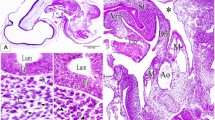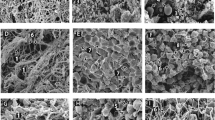Abstract
THE papers by McKay et al.1–3, the recent publications by Bartone4, and others5, suggest that interest is increasing in embryological histochemistry. Consequently, it was felt it would be of value to note briefly the aortic histochemical polysaccharide investigations made on 12 human embryos ranging from 2.5 to 20.0 mm, crown-rump length. Serial sections from 10 per cent buffered formalin-fixed material, prepared by the paraffin process, were made from normal embryos of 2.5, 3.0, 5.5, 5.6, 6.5, 6.6, 10.0, 13.0, 14.4, 17.0, 19.0, and 20.0 mm, crown-rump measurements. The bulk of the embryos were obtained incident to hysterectomies with two of the older specimens coming from spontaneous abortions. The sections were serially stained for examination by the following microtechnical6 and histochemical techniques7: (1) hæmotoxylin and eosin; (2) Goldner connective tissue stain; (3) periodic acid–Foot stain for reticular tissues; (4) orcein elastic tissue stain; (5) Best carmine method for glycogen (diastase controlled); (6) original and Rinehart–Abu'l Haj modification of the Hale colloidal iron procedure for acid polysaccharides; (7) alcian blue method for acid polysaccharides; (8) McManus periodic acid–Schiff technique for neutral polysaccharides; (9) catalysed glacial acetic acid lead tetraacetate procedure, also for neutral polysaccharides. Metachromatic localizations8 were used, but not for the entire series. In the light of the form of fixation and the routine mounting, it was felt best not to include these sections in this discussion (these localizations resembled those obtained with the alcian blue technique). It was felt that this series of methods would adequately disclose the polysaccharide picture in the developing aorta and the relationship of these localizations to the forming connective tissue components of the embryonic vessel wall.
Similar content being viewed by others
Article PDF
References
McKay, D., Hertig, A., Adams, E., and Danziger, S., Anat. Rec., 117, 201 (1953).
McKay, D., Adams, E., Hertig, A., and Danziger, S., Anat. Rec., 122, 2 (1955).
McKay, D., Adams, E., Hertig, A., and Danziger, S., Anat. Rec., 126, 433 (1956).
Bartone, J., Anat. Rec., 145, 204 (1963).
Barka, T., and Anderson, P., Histochemistry, Theory, Practice and Bibliography (Hoeber Medical Division, Harper and Row, New York, 1963).
Little, R. D., Histopathological Technic and Practical Histochemistry (Blakiston Division, McGraw-Hill Book Co., New York, 1954).
Pearse, A. G. E., Histochemistry, Theoretical and Applied (Little, Brown and Co., Boston, 1960).
Kramer, H., and Windrum, G., J. Histochem. Cytochem., 3, 227 (1955).
Author information
Authors and Affiliations
Rights and permissions
About this article
Cite this article
LHOTKA, J. Histochemical Localizations of Polysaccharides in the Developing Human Aorta. Nature 202, 1124 (1964). https://doi.org/10.1038/2021124a0
Issue Date:
DOI: https://doi.org/10.1038/2021124a0
Comments
By submitting a comment you agree to abide by our Terms and Community Guidelines. If you find something abusive or that does not comply with our terms or guidelines please flag it as inappropriate.



